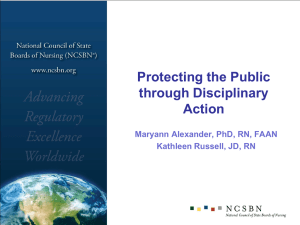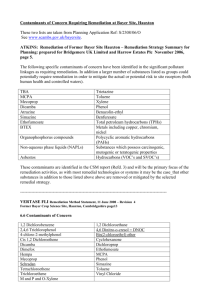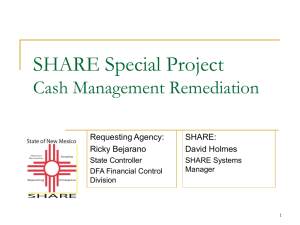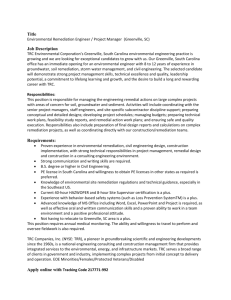CDBG Program IDIS Version 11.4
advertisement
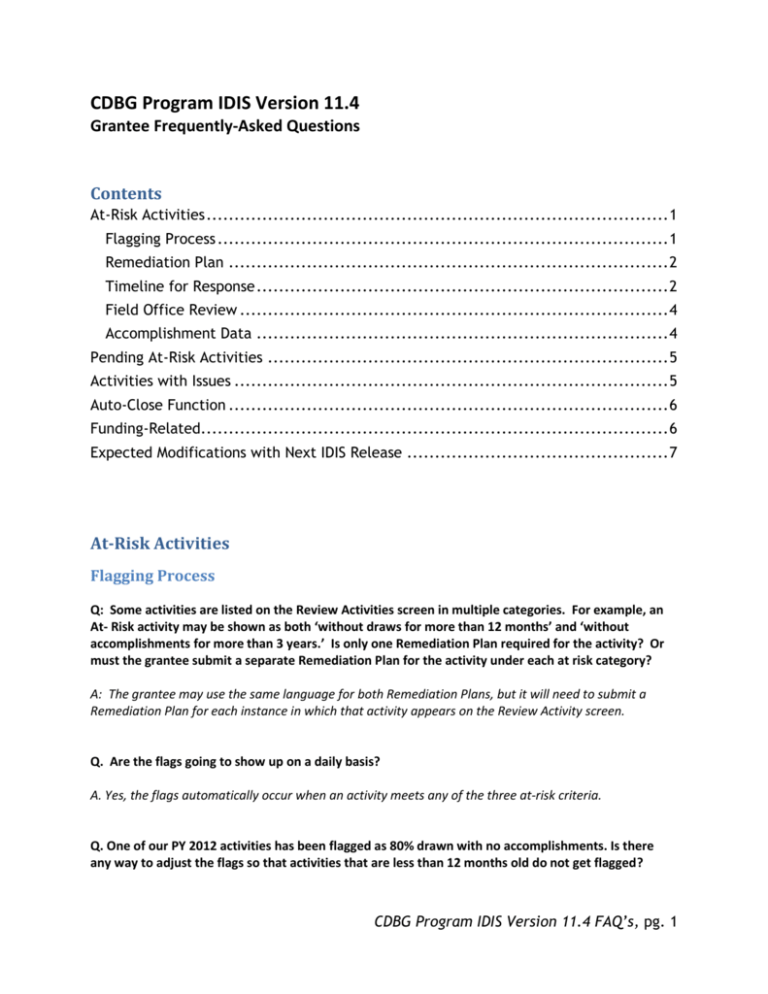
CDBG Program IDIS Version 11.4 Grantee Frequently-Asked Questions Contents At-Risk Activities ................................................................................... 1 Flagging Process ................................................................................. 1 Remediation Plan ............................................................................... 2 Timeline for Response .......................................................................... 2 Field Office Review ............................................................................. 4 Accomplishment Data .......................................................................... 4 Pending At-Risk Activities ........................................................................ 5 Activities with Issues .............................................................................. 5 Auto-Close Function ............................................................................... 6 Funding-Related.................................................................................... 6 Expected Modifications with Next IDIS Release ............................................... 7 At-Risk Activities Flagging Process Q: Some activities are listed on the Review Activities screen in multiple categories. For example, an At- Risk activity may be shown as both ‘without draws for more than 12 months’ and ‘without accomplishments for more than 3 years.’ Is only one Remediation Plan required for the activity? Or must the grantee submit a separate Remediation Plan for the activity under each at risk category? A: The grantee may use the same language for both Remediation Plans, but it will need to submit a Remediation Plan for each instance in which that activity appears on the Review Activity screen. Q. Are the flags going to show up on a daily basis? A. Yes, the flags automatically occur when an activity meets any of the three at-risk criteria. Q. One of our PY 2012 activities has been flagged as 80% drawn with no accomplishments. Is there any way to adjust the flags so that activities that are less than 12 months old do not get flagged? CDBG Program IDIS Version 11.4 FAQ’s, pg. 1 There are a lot of activities that by their nature cannot enter accomplishments until they are 100% complete. A. No, the flags cannot be adjusted; however, there will be many activities that will appear on the at-risk list that will be easily approved by the field office because of the nature of the activity, especially public facilities and economic development activities. The purpose of these changes is to strengthen HUD’s oversight of CDBG activities. Remediation Plan Q: Regarding the activities listed on the Review Activities screen, I understand that when a grantee completes an activity, that activity will be removed from the list. Do we, as grantees, have to submit a Remediation Plan first, or can we simply complete that activity without having to explain that action in a Remediation Plan? A: The purpose of the Review Activities screen is to ‘move activities along’ in the system and in real life. So, by all means, if you can complete the activity in IDIS—thus removing the flag, then please do so. You do not need to submit a Remediation Plan as long as you complete that activity during the three month period following it being flagged. Q: What is the expectation of HUD for very old (10 years+) at-risk activities? Do grantees have to submit a Remediation Plan? A: The expectation for very old at-risk activities is the same as for all activities that are on this list. Therefore, yes, grantees do have to submit a Remediation Plan for these activities. Q: What is the difference between completing remediation actions and meeting the IDIS completion criteria for an activity? A: The remediation actions are short term actions implemented by the grantee to move a stalled activity forward. The IDIS completion criteria are specific data elements required to complete an activity in IDIS. These data elements must be entered into IDIS as evidence that the activity met program requirements. If a grantee cannot complete a flagged activity because it does not have the required data, it will need to enter a remediation plan instead. Ideally, the remediation plan actions should speak to the steps the grantee will take to obtain and enter the data so that the activity can be completed. Timeline for Response Q: Is it the expectation that all the at-risk activities have a Remediation Plan submitted and approved by May 27, 2013? A: All activities that were flagged on the very first day of the release should have a submitted and approved (or disapproved) Remediation Plan by May 27, 2013. Any activities that are flagged after this CDBG Program IDIS Version 11.4 FAQ’s, pg. 2 initial date and up until May 27, 2013 will each have 90 days to submit the plan and 90 days for the field office to approve or disapprove the Remediation Plan. Q. Is the six month timetable for implementing remediation actions targeted at spending all available funds or simply about moving an individual activity forward toward completion? A. All funds do not have to be expended during the six month timetable. The Target Completion Date is up to 6 months from the date your Remediation Plan was submitted and is the date by which your remediation actions should be completed. That wouldn't necessarily include expenditure of all available funds; it depends on your Remediation Plan for that particular activity. And yes, it's fair to say that the overall goal is to get activities moving forward. Q: What happens if a Remediation Plan is not submitted by the deadline indicated on the Remediation Plan? A: If a Remediation Plan is not submitted within 90 days of flagging, the activity will appear on the ‘Overdue’ section of the Activity Review screen, and the grantee will be sent an email asking it to complete or cancel the activity and return all drawn funds. Q: Can a Grantee request an extension if it is unable to meet the six months remediation timeline? A: No, the grantee cannot receive an extension in the IDIS system itself for completing the actions in the Remediation Plan; however, the remediation timeline does not require that the activity be cancelled or completed within six months—it is simply a plan for moving the activity forward (drawing funds, reporting accomplishments, etc.) You should be discussing any issues you are having in moving the activity forward with your field office. Again, these system changes are meant to serve as management tools, not compliance tools. Q: I understand that after the initial six month period, grantees will only have two weeks to submit Reasons for Delay and remediation actions for a flagged activity. Will the system automatically notify the grantee when activities have been flagged? A: The grantee will not receive an email, but the activity will appear on the Review Activities screen. This means that grantees will need to access IDIS on a regular basis—which we itself should improve grantee data management. Grantees can get a sense of what activities are in the pipeline to become ‘At-Risk’ activities by checking the Pending At-Risk list on the Review Activities screen. Q: Why must remediation be complete in 6 months? A project can take more than 2 years to complete. A: HUD needs to see short term remediation actions that will move the activity forward. We understand that the activity itself may not be completed in 6 months. CDBG Program IDIS Version 11.4 FAQ’s, pg. 3 Q: How can we tell when an activity’s Remediation Plan is due? There is no due date listed on the Review Activities screen for each flagged activity. A: That was an omission that will be corrected in the next release. However, until then, grantees will have to click on the link labeled ‘Reason’ next to each activity which takes you to the Remediation Plan screen for each activity. This screen provides the date by which the Remediation Plan must be submitted. Field Office Review Q. Is it a good idea to start remediation steps if the Remediation Plan may not be approved by my field office? It looks like a 3 month overlap will occur where a grantee could be implementing a remediation plan that may not be approved. A. Grantees will initially have 3 months from the flagged date to submit the Remediation Plan. Then the field office has 3 months from the plan submittal date to approve or disapprove the plan. So the two 3 month timelines do not overlap. But yes, the 3 months for approval after submittal will overlap with your timeline to remediate. In the meantime, if you can move an activity forward, towards a national objective, or towards completion, that is really the overall goal of the At-Risk list—so feel free to start implementing your plan without field office approval in the system. If you have any questions regarding your remediation actions before plan approval, please consult your field office. Q: If the field office rejects a Remediation Plan can a new Remediation Plan be submitted for the same flagged activity? A: Field offices and grantees are encouraged to discuss any necessary revisions to Remediation Plans before the step is taken to reject them in the system. The grantee can go back and edit the Remediation Plan up to the point when it is accepted or rejected by the field office. Once a Remediation Plan has been rejected by a field office, it is not possible to revise the plan or to submit a new Remediation Plan. Q: Once a grantee submits a Remediation Plan, can it still access the plan or is it locked up until the Field Office approves it? A: A grantee will be able to edit the Remediation Plan for an activity at any point up until it is approved or rejected. PLEASE NOTE, once it is approved or rejected, it cannot be edited—but up until that point, feel free to edit it as needed. If you are planning to edit it after you have submitted it to your field office, please communicate that with your field office representative. Accomplishment Data CDBG Program IDIS Version 11.4 FAQ’s, pg. 4 Q: What constitutes a "reported accomplishment?"? Can you clarify the difference between accomplishment data and beneficiary data, especially as it relates to these new system functionalities? A: Accomplishment data are the numeric accomplishments, beneficiary information, and performance measures that are required for the completion of an activity in the system. Accomplishment narratives are not required but are encouraged. Beneficiary data are part of the accomplishment data for direct benefit activities and are generally found on the CDBG Accomplishment Detail (Page 1 screen). Q: If a grantee indicates that accomplishments for an activity are to be reported under another activity, then this activity is not going to be listed as “At-Risk,” right? :If the grantee indicated that accomplishments for activity “A” are reported in another under activity “B”, then activity “A” will not be flagged as at-risk for the ‘no accomplishments in 3 years’ category. Activity “B” could get flagged if it fails/meets one of the three at-risk criteria (for example, because the accomplishment data has never been entered after 3 years). And, activity “A” could still be flagged for one of the other at-risk criteria – for example, because there have been no draws in 12 months. Pending At-Risk Activities Q: If an activity has been marked as ‘Pending At-Risk’ (and therefore, does not yet require a Remediation Plan) because of ‘no accomplishment data in 3 years,’ and the grantee updates the activity’s accomplishments in IDIS, will it be removed from the pending at-risk list as a result? A: Yes, updating an activity’s accomplishment data does remove it from the pending list. The activity will be removed from the pending at-risk list for “no accomplishments reported for 3 years.” If the activity was also listed on the pending at-risk list for “80 percent drawn and no accomplishments reported,” it will be removed from that list. However, if the activity was also on the pending at-risk list for “no draws within 12 months,” it will still be on that list unless a new draw has been made. Q: Do Pending At-Risk activities require any action by the grantee? Do they require all of the same steps as At-Risk activities? A: No. Pending At-Risk activities require no immediate actions. However, it would be a good idea to resolve the at-risk factor or complete or cancel the activity before the activity is flagged and becomes part of the At-Risk list, so you can avoid all of the steps that would be required as a result. This is the purpose of the Pending At-Risk lists. Activities with Issues Q: I have several activities that were on the OIG list that we are unable to complete or edit in the IDIS due to system errors (options are "grayed out,” etc.). In response to the OIG audit, we requested that CDBG Program IDIS Version 11.4 FAQ’s, pg. 5 HUD Headquarters close those activities on our behalf. However, now they are flagged in the system. What steps should we take now to get them closed? A: If your field office submitted these activities to HUD Headquarters to edit and complete, we are working to get these activities completed in the system by the end of January. If you have any additional activities that you have issues completing, cancelling, or editing in the system, please contact your field office to request Headquarters assistance. Auto-Close Function Q: Does ‘auto close’ mean the activity will be completed in IDIS or cancelled in IDIS? A: ‘Auto close’ means an activity will be automatically completed, not cancelled. This new functionality will only occur with planning and admin activities (other than State Planning, 20A) for which the grantee fails to submit a Remediation Plan, or for which the grantee misses a deadline. However, activities that are auto-closed are able to be re-opened in the system by the grantee if necessary. If the grantee reopens an auto-closed activity, the grantee should be aware that all funds that were not expended prior to the auto-completion were returned to their Balance to Commit. (This is the same process which occurs with any other completed activity in the system.) Q: When IDIS Auto-Closes an activity, will it be indicated that it was auto-closed? A: Yes, it will be listed as auto-closed on the Review Activity screen and on the PR-59 report. Funding-Related Q: Can grantees draw down funds for an activity that has been flagged as at risk when the Remediation Plan for that activity has not been approved by the field office? A: Yes, you can draw funds on the activity at any point. Q: What does HUD mean when the system says that an activity must "reimburse all drawn funds" upon cancellation? Where do the funds for reimbursement come from? A: The reimbursement would come from a non-federal source of funds, such as general funds. Q: For activities with no draws, can the grantee cancel the activity in IDIS and then reprogram the funds back into the same activity? A: Yes, there is nothing that would stop a grantee from doing this. CDBG Program IDIS Version 11.4 FAQ’s, pg. 6 Q: If funds are returned to the grantee’s line of credit, will the next LOCCS draw be reduced by the “returned” amount? A: When a grantee is required to reimburse funds for a failed activity, only EN (grant) funds are reimbursed to the grantee’s Line of Credit. Instructions for doing so an for zeroing out the original activity can be found in the ‘Additional Materials’ section of the IDIS Resources for CDBG Program webpage. Expected Modifications with Next IDIS Release Q: Should we expect any modifications to the At-Risk Activity process in the future? A: Yes, a number of modifications will take place with IDIS Release 11.5, scheduled for May 18, 2013. These modifications include: Only one Remediation Plan will be required per At-Rick Activity, no matter how many “at-risk” conditions the activity meets. Public facilities and economic development (except for 18B ED Technical Assistance) activities will be exempt from the “80 percent of their funded amount disbursed and no accomplishments reported” flag. Due dates for Remediation Plans will appear on the Review Activities list. In addition to the above changes, the emails that are sent to grantees when Remediation Plans are overdue will not be operational under this next release. CDBG Program IDIS Version 11.4 FAQ’s, pg. 7


